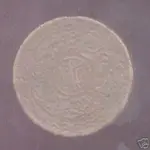michanddave:
In Islamic nations, portraiture was prohibited under religious law, and therefore the coinage bore no portraits, just artistically arranged inscriptions. One of the most distinctive of these Islamic renditions is shown on the top picture of your Ottoman 'kurush' (?) piece.
The symbol on the top coin pic, a “tughra,” was used for centuries as the official mark of the sultan of the Ottoman Empire and appeared on coins, notes, stamps, and other documents. It was said to have originated with Sultan Murad I (1360–1389) who, unable to sign his name, dipped his hand in ink and pressed it onto the paper of a treaty. The three vertical strokes of the tughra supposedly represent the ring, index, and middle fingers; the extension to the right, the small finger; and the curved line to the left, the thumb. From sultan to sultan, the general design of the tughra remained the same, but each sultan's mark was distinctive, consisting of a complex monogram formed by the ruler's name, that of his father, the title khan, and the epithet, 'ever victorious.' The tughra was typically centered on the obverse of the coin with various symbols to the right and the regnal year of the sultan below.
I didn't answer your question, but hopefully, made the search more interesting.
Don..
(Source:
http://66.102.7.104/search?q=cache:...Zagon+tughra&hl=en&gl=us&ct=clnk&cd=2&ie=UTF-)



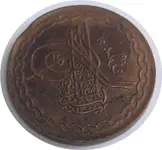
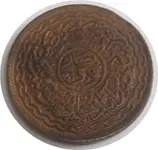
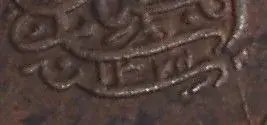
 Lot 1279 India. 1 Dinar, ND (Hadrat Dehli). Fr-453. Mohammad III Bin Tuqhlaq, AH725-752 (1325-1351). Arabic legend. NGC graded AU-50.
Lot 1279 India. 1 Dinar, ND (Hadrat Dehli). Fr-453. Mohammad III Bin Tuqhlaq, AH725-752 (1325-1351). Arabic legend. NGC graded AU-50. 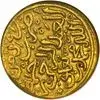
 -Ben
-Ben HYDERABAD 1ANNA BRASS COIN,Hyderabad coin with 400years old charminar famous south indian structure built four hundred year ago by quliqutabshah in rememberence of his lover bhagamathi this structure of built with only with the measure of brick and land still in tack without any dimage there is no other structure built like these in used dimension anywhere in the world.these coin is issued by father last NIZAM mohoob ali pasha asafjha VI 1869to1811. first machine mint which
HYDERABAD 1ANNA BRASS COIN,Hyderabad coin with 400years old charminar famous south indian structure built four hundred year ago by quliqutabshah in rememberence of his lover bhagamathi this structure of built with only with the measure of brick and land still in tack without any dimage there is no other structure built like these in used dimension anywhere in the world.these coin is issued by father last NIZAM mohoob ali pasha asafjha VI 1869to1811. first machine mint which